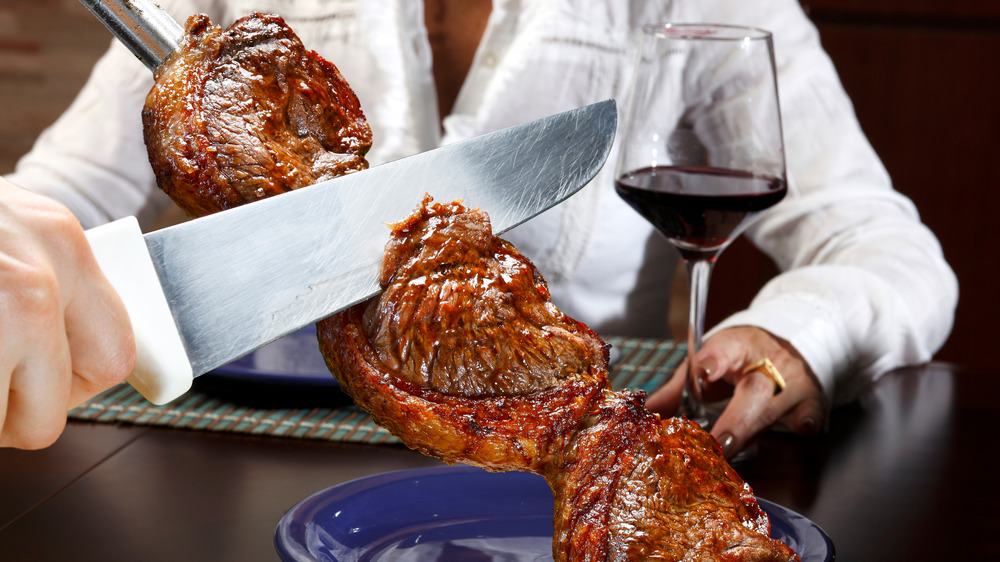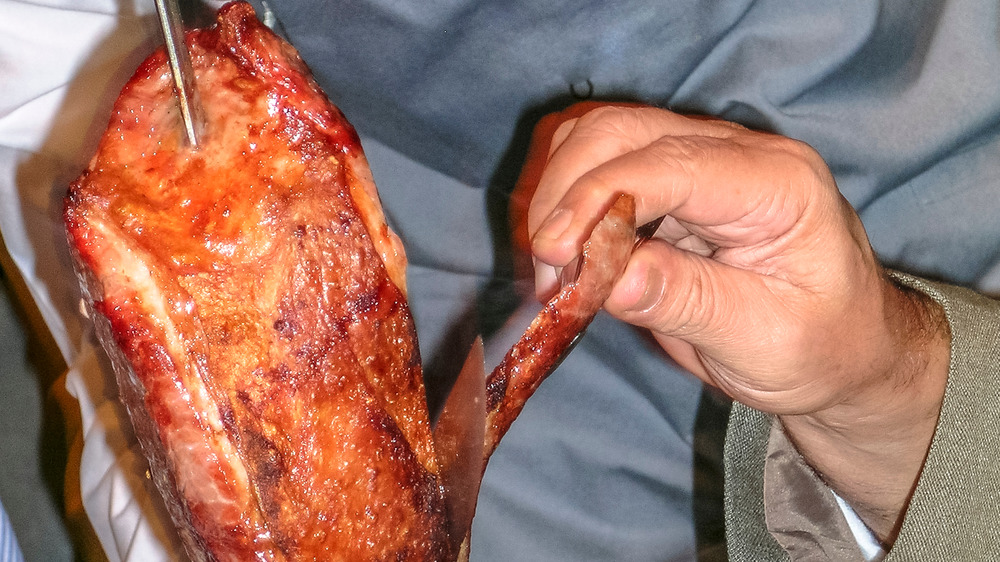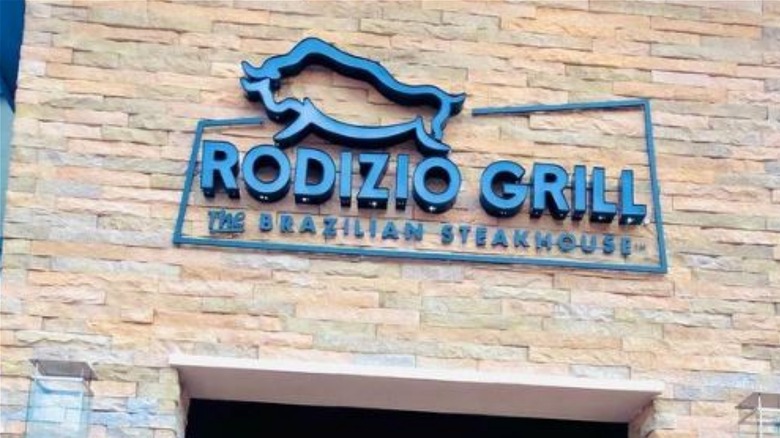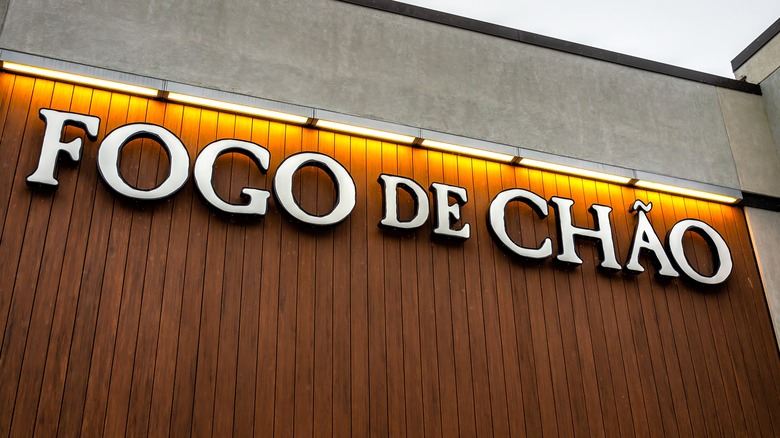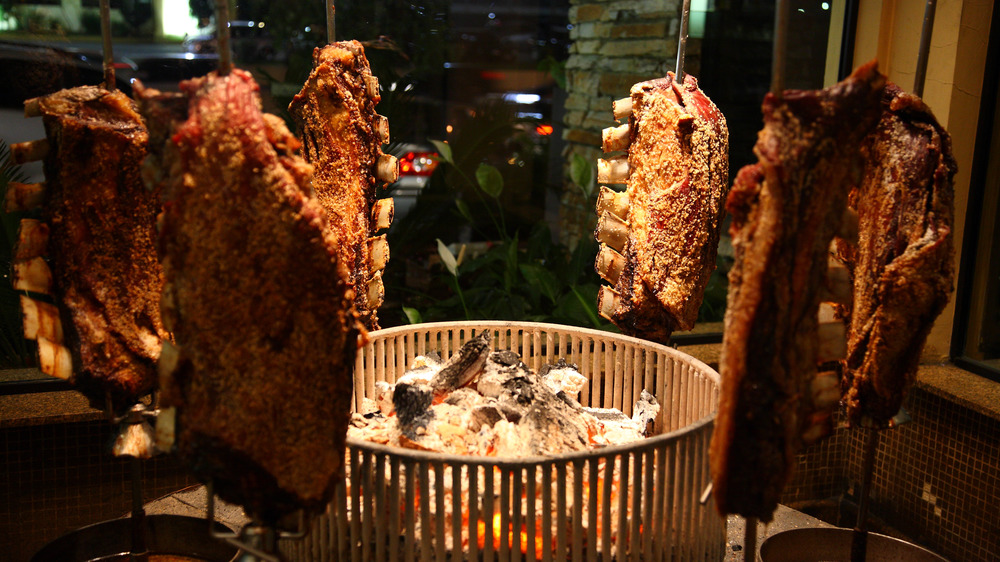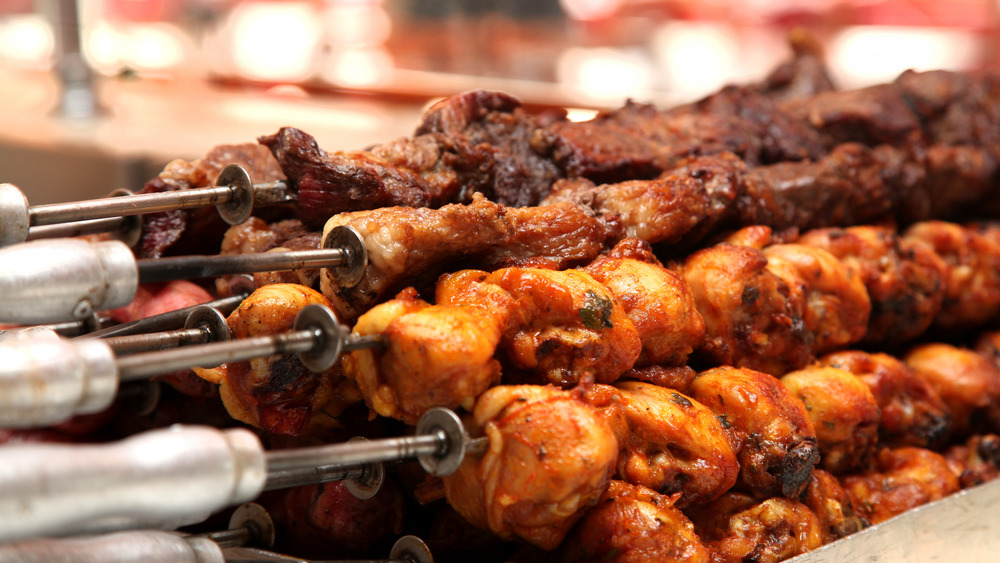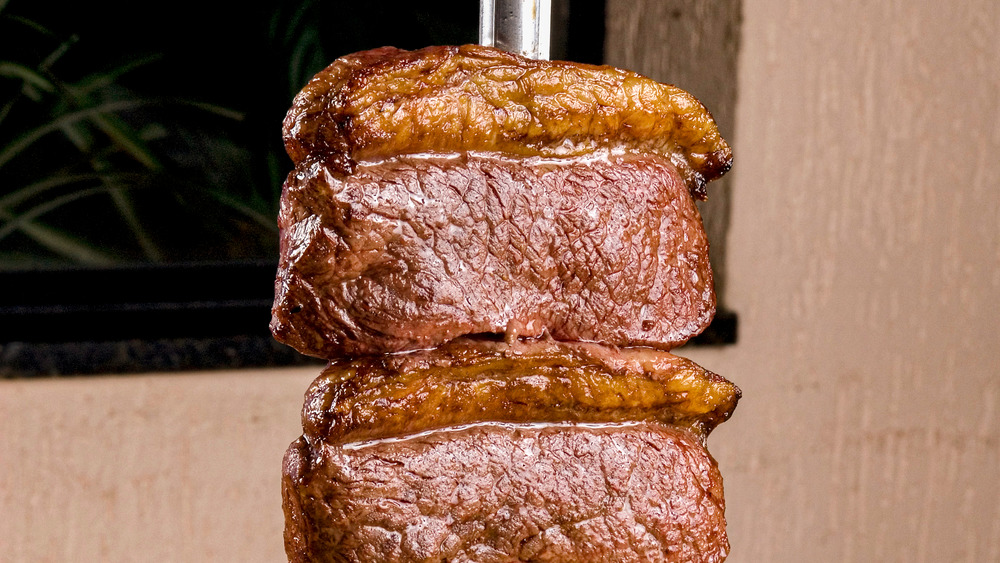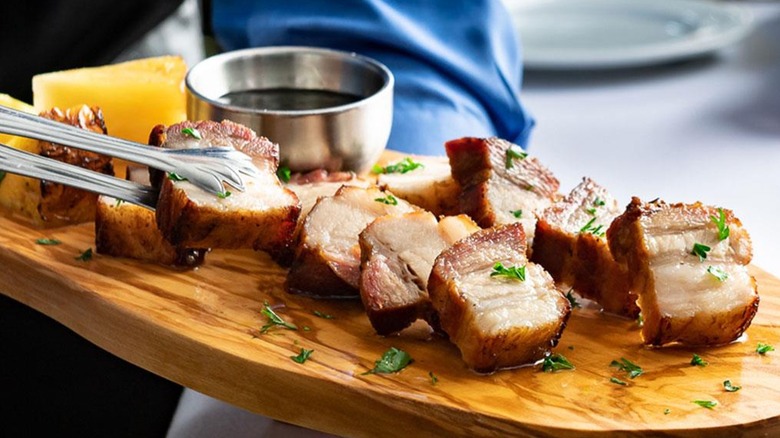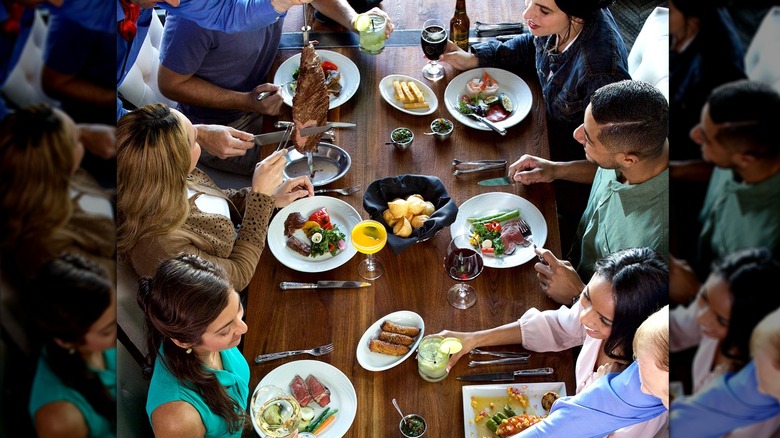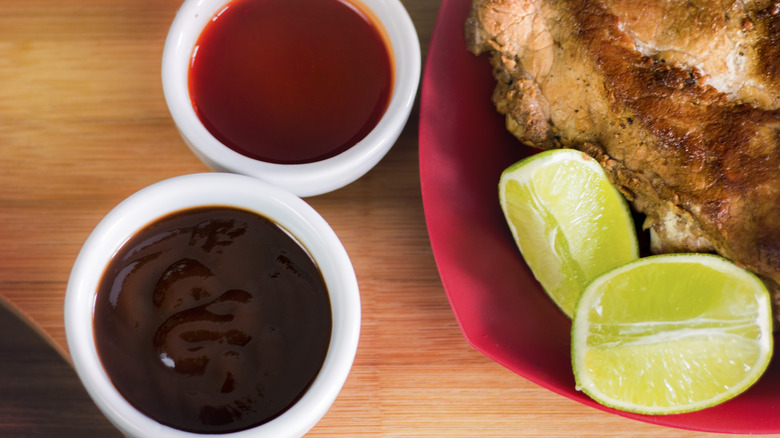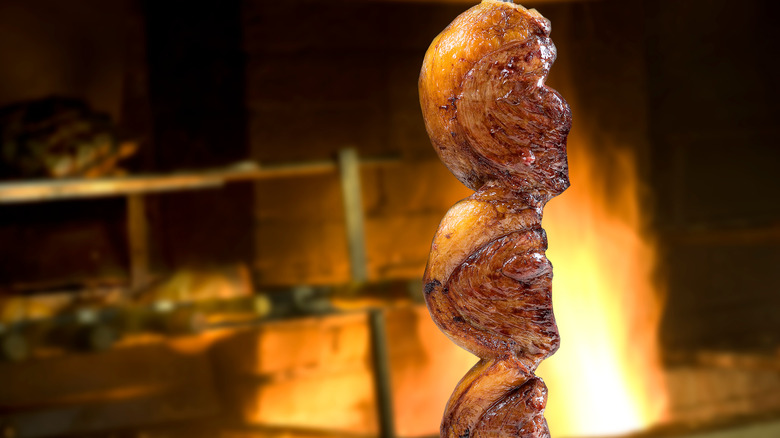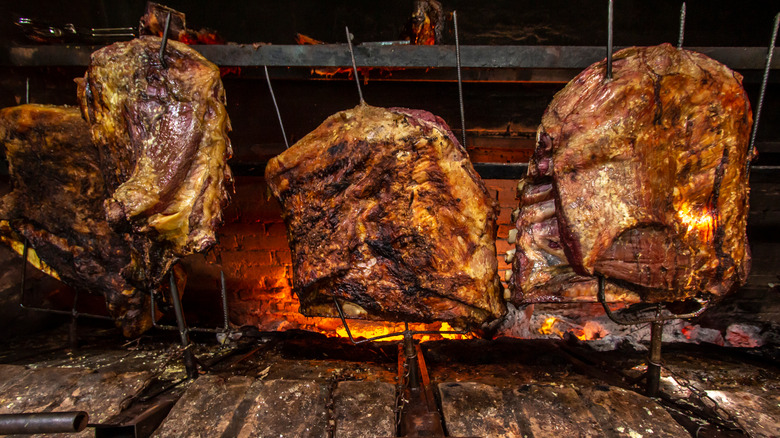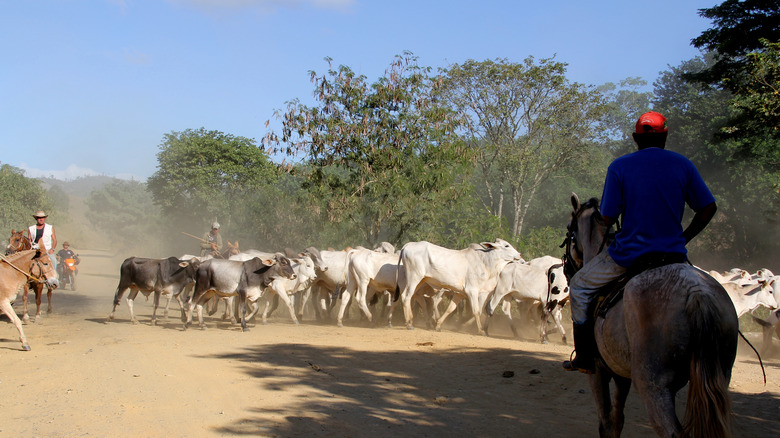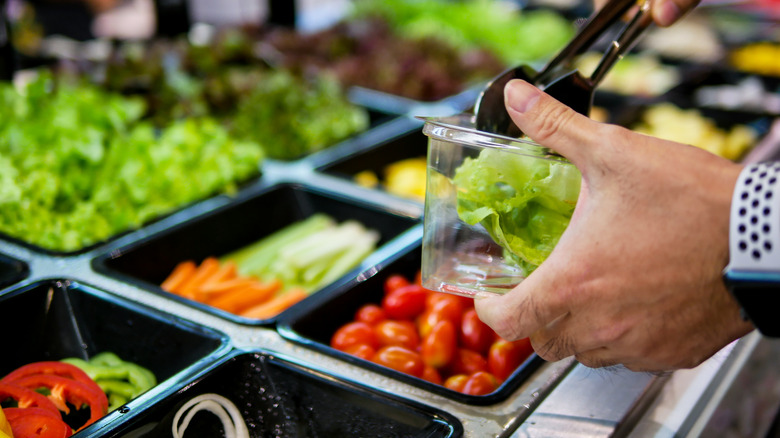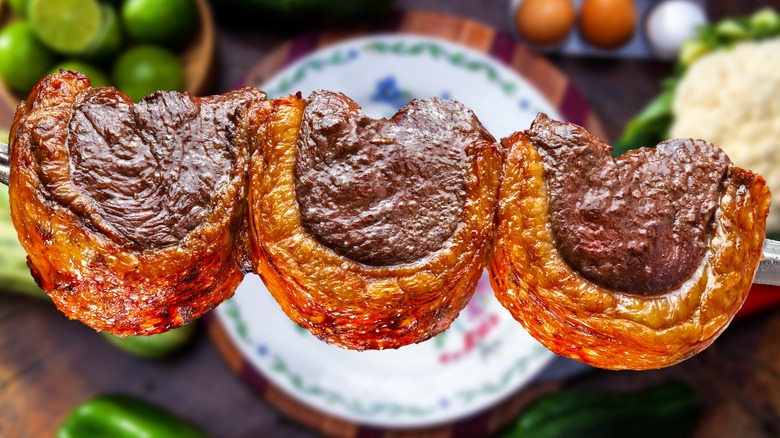The Untold Truth Of Brazilian Steakhouses
Though the U.S. is well-known for its culinary prowess, Brazilian food gives Americans a run for their money. Brazilian steakhouses are popular around the world for their all-you-can-eat meats and rodízio-style dining (think buffets but delivered directly to you — no room-temperature steak).
Brazilian steakhouses offer diners more than just meat, however. Brazilian culture is infused into the entire churrascaria experience. Arri Coser, who, along with his brother, owns the popular Brazilian steakhouse chain Fogo de Chão, told Eater the key to their success was "our culture." "We went to the U.S. not only with our barbecue and the culinary techniques we learned from our parents and grandparents. We took our way to serve it, our Brazilian hospitality, the experience of an authentic Brazilian churrasco." It's a hit, too.
By our count, there are more than 170 Brazilian steakhouse restaurants scattered across the United States, which makes finding the best Brazilian steakhouses a bit of a challenge. But it's a challenge well worth the effort. From the moment you take your seat in one of them, it's an experience to be remembered — flip your card to green to signal you're open for food and get ready for a true Brazilian meal!
Churrasco is more than just Brazilian barbecue, it's culture
The Portuguese word "churrasco" means "barbecue" in English and can be used to refer to all kinds of grilled meats. More often, however, churrasco refers to a specific method of Brazilian grilling in which beef is barbecued on a long skewer and served by cutting off individual slices. Brazilian steakhouses use this technique to cook and serve a variety of different meats, from picanha (sirloin cap) to lombo (pork loin).
But for Brazilians, churrasco is much more than just a cooking method. Churrasco, like much regional cuisine, defines a culture and a way of life. Brazilians celebrate their homemade barbecue no matter if they're throwing a party or just relaxing with friends and family. Though you may not be able to travel to Brazil to experience the churrasco way of life, traditional Brazilian steakhouses can give you a glimpse of what that life includes.
Rodízio-style dining at Brazilian steakhouses
Most Brazilian steakhouses serve food using a unique method that lies somewhere between buffet and family-style dining. Rodízio, which translates to "rotation," requires diners to pay a fixed price for a variety of all-you-can-eat options. Most steakhouses have a salad bar, but the main course is paraded out of the kitchen on large skewers, which servers slice directly onto diners' plates.
According to legend, the rodízio style of dining started when a waiter, at a restaurant called Churrascaria Matias in the state of Rio Grande do Sul, mistakenly brought a meat skewer to a table that didn't order it. Instead of immediately correcting his mistake, the waiter allowed the diner to try the dish anyway, and so a great tradition was born (via Eater).
Rodízio started becoming popular in the mid-20th century when restaurants began feeding truck drivers as the profession became more common along with the rise of road construction in Brazil. Because of Brazil's many cattle herds, meat was cheap to buy; because of the simple churrasco tradition, it was also easy to make. Hungry travelers were eager to get their hands on it when they stopped to rest and refuel.
The first Brazilian Steakhouse in America opened in 1996
Brazilian steakhouses have spread across the country over the last few years, but they have actually been in the United States for nearly three decades. The first American churrascaria, Rodizio Grill, opened its doors in Colorado in 1996.
Rodizio Grill's founder, Ivan Utrera, was born and raised in São Paulo, Brazil, before coming to America in the 1980s to study. After college, he eventually worked his way up to become a marketing executive for Pizza Hut. He found the job confining, however.
In 1995, he went into business for himself in an attempt to bring more of the Brazilian culture to his new home in the states. Working with his culinary teacher mother, Utrera gathered enough recipes to open his first restaurant the following year. Over the next few years, three more Rodizio Grills would open in Colorado and another in Texas. The chain has since expanded to more than 20 locations across the country.
Fogo de Chão is largest Brazilian steakhouse chain in the United States
While Brazilian steakhouses have been popping up left and right across the United States over the past 20-plus years, one reigns supreme: Fogo de Chão. The now-ubiquitous brand opened the doors to its first U.S. location in Dallas, Texas, in 1997. It is now the largest Brazilian steakhouse chain in the country. In a 2022 report of the largest chains from Nation's Restaurant News and Datassential, Fogo de Chão had 55 locations to its name. Next up was Texas de Brazil, boasting 52 restaurants. While the two brands were separated by a mere three outposts, Fogo de Chão was the clear winner when it came to revenue. The segment leader brought in $511.7 million in sales in 2022, more than double Texas de Brazil's estimated $241.3 million.
Since then, Fogo de Chão has only expanded its lead and taken an even bigger chunk out of the Brazilian steakhouse pie. While Texas de Brazil still has just north of 50 restaurants, Fogo de Chão has grown its footprint to 66 locations across the United States by early 2024. And it is not stopping there. In late 2023, the company announced a goal of reaching 100 restaurants and $1 billion in annual revenue within the next five years.
You might not find cuts of meat you're used to at Brazilian steakhouses
Though the meat on a Brazilian steakhouse menu might not be familiar to outsiders, locals know these dishes well. From picanha to fraldinha, Brazilian meats — especially churrasco-style — are some of the best you'll ever have.
Some of the most common cuts of meat you'll encounter at a Brazilian steakhouse are picanha, filet mignon, chuleta, and fraldinha. Picanha is the most traditional cut, taken from the top of a cow's rump and seasoned with salt. It gets skewered into a C-shape when it cooks over open flames. Though filet mignon is a well-known cut of beef, sometimes you'll find it dressed up in bacon or a Parmesan crust. Chuleta is whole cuts of ribeye steak that get skewered and roasted, and fraldinha is a cut of bottom sirloin that's marbled with fat and served in long flat pieces.
If you go to a Brazilian steakhouse, get ready to eat a lot of meat
If you consider yourself a big carnivore, a Brazilian steakhouse is the place for you. The Brazilian steakhouse experience centers around, well, steak — and lots of it. The popular chain Fogo de Chão has been called a "meat-eater's mecca" because it offers "all the meat you can eat," and in that sense, it's not unique among Brazilian steakhouses, according to Eater. However, when former Dallas Morning News food writer Dotty Griffith reviewed a Brazilian steakhouse back in 1997, she told Eater, "Americans and Texans are used to all-you-can-eat salad bars, but all you can eat grilled steak and other meats was new at the time."
Not for the faint of heart (or vegetarians), a typical Brazilian steakhouse will leave you feeling stuffed to the brim, sure you can't eat another bite — until, of course, a server comes by the table with a new skewer of delicious grilled meat. With so many options to choose from, if you leave the restaurant walking upright, you're doing it wrong. Though you might assume that America's huge portion sizes have prepared you for this moment, Brazilian steakhouses take it to a whole new level — brace (and pace!) yourself.
Brazilian steakhouse meat is cooked using simple methods
Churrasco-style grilling was created to show off the pure essence of the meat. Most of the time churrasco meats are seasoned only with salt before being put on the grill; the skewers are sometimes stacked on top of one another with the fattier cuts on top so the juices drip down and infuse all of the other meats with flavor (via The Spruce Eats).
Brazilian barbecue lacks the smoky flavor that's popular in Texas and the U.S. more broadly because Brazilian gauchos wanted to preserve the basic flavor of their farm-raised beef. Instead of smoking the meat, which alters the taste, they roasted it slowly on skewers until the outer layer was nicely seared and the inside was tender and juicy. Though beef is the most common kind of churrasco meat offered at Brazilian steakhouses, it isn't the only type of meat cooked in this style.
Brazilian steakhouses serve meats that aren't beef
If you are not a beef eater, you might think a Brazilian steakhouse is not for you — and granted, you are probably not its target demographic. But if you think you still can't have a delicious, belly-filling meal, you are dead wrong.
Brazilian steakhouses are more about food than they are about steak. Therefore, you will find plenty of other meats on the menu. This usually includes several chicken, lamb, and pork dishes. One popular non-beef dish you'll find at most Brazilian steakhouses is lombo. This cut of pork loin is typically encrusted with a layer of Parmesan cheese, which serves the dual purpose of adding flavor and sealing in the meat's juices. Other oft-served non-beef dishes include lamb picanha, lamb chops, chicken breast, pork belly, and pork sausage.
And let us not forget about our pescatarian friends — there is a great meal waiting for you at a Brazilian steakhouse as well! Salmon, shrimp, and even lobster and sea bass are common options to be had as either appetizers or part of the churrasco experience.
The dress code at Brazilian steakhouses is more casual than at traditional steakhouses
Most U.S. steakhouses are upscale eateries. As such, they often have formal dress codes that prohibit diners from wearing such items as sweatshirts, athletic apparel, baggy clothes, or beach attire.
But, if you haven't figured it out already, Brazilian steakhouses are far more casual than the traditional steakhouses you are used to. This stays true all the way down to what customers are allowed to wear in the restaurant. Fogo de Chão, for example, recommends "smart casual attire" but does not adhere to a formal dress code. "The dress code is come as you are," one diner wrote on Yelp. "I was there during a weekday business luncheon and wore business casual. Nevertheless, I have seen Facebook posts where people have worn athletic gear." It is the same policy you will find at Texas de Brazil. "While we recommend smart/business casual, we do not enforce a dress code as long as clothing is reasonable and does not depict anything that might be offensive to other guests," the chain's website reads.
So, if you're heading out for your first Brazilian steakhouse experience, dress as formally as you like. But, remember, you will be eating a lot of food, so maybe a relaxed fit would be best.
To balance out the fatty meats, Brazilian steakhouses often serve acidic side dishes
Because Brazilian steakhouse cuisine relies so heavily on fats in the main course, most side dishes are highly acidic to act as a counterbalancing force. One of the most popular dishes is a sauce that's often served over the meats (via Insider). Called molho campanha, it's similar to a salsa and is meant to enhance the flavor of the beef. Molho campanha is easy to make — all it takes is red and green peppers, onion, tomatoes, vinegar, and some simple knife skills.
A similar theory comes into play when pairing your meal with a drink — you'll want to choose something acidic to balance out the rich flavors of all that meat. One mistake that too many diners visiting a Brazilian steakhouse make is not ordering a caipirinha, which is Brazil's national cocktail. It makes a great complement to all that grilled meat. It's easy enough to make at home if you can't wait for the steakhouse. The drink is made by combining lime, sugar, and cachaça, a Brazilian spirit made with fermented sugar cane.
Picanha is the most traditional Brazilian cut
Picanha is the best and most traditional meat available at a Brazilian steakhouse; no true Brazilian barbecue is complete without it. And if you're looking for a real Brazilian churrascaria experience, you must try some picanha. Similar to a sirloin in flavor and texture, this cut is taken from the backside of the cow in the fatty area above the butt. According to Over the Fire Cooking, most U.S. butchers break down this piece of meat into smaller cuts, thus losing the fat cap that gives picanha much of its flavor in the process.
It's the fat cap that infuses picanha with a juicy tenderness unrivaled by other cuts of beef. Surprisingly, despite its extraordinary taste, picanha is actually pretty inexpensive. According to Steak School, sometimes it can be hard to find at the grocery store, but your local butcher should have it.
You should avoid eating at a Brazilian steakhouse for dinner
Brazilian steakhouses are so good you might be tempted to go for every meal, but let us be the ones to advise against that. In fact, most people suggest that lunch is the only meal for the steakhouse — if you go all out later in the day, well, there's no telling what could happen. Experts in this style of dining recommend you spend an afternoon with all the Brazilian barbecue your little heart desires, leaving yourself plenty of time to walk it off before lying down.
Eating anything too close to bedtime can induce heartburn, nausea, or bloating — eating a whole pile of meat is likely to make those symptoms much worse. To fully enjoy the whole Brazilian steakhouse experience, it's best to have this meal earlier in the day so your body can properly digest with the help of gravity — that means no afternoon naps, either!
Brazilian cowboys originally came up with these steakhouse recipes
Brazilian cowboys, or gauchos, were the first to cook meats Brazilian steakhouse-style in the 1800s. The men would spend their days herding cattle and their nights grilling the meat over a fire for their friends and family. They prepared the food the same way it's done now: just a sprinkle of salt and a slow roast over hot coals. Back in the beginning of churrasco, gauchos dug pits in the ground to build their fires and waited until it was extremely hot before skewering the meat and starting the roasting process.
Usually in those days, the men oversaw the meat — from pasture to butcher to spit — while the women gathered the food they had grown in gardens and prepared side dishes. The meal was a family effort and a celebration — the gauchos and their families gathered around the fire together similar to the way you might gather with family and friends around the table to enjoy the same Brazilian meats.
Skip the salad bar at Brazilian steakhouses
If there's anything to skip at a Brazilian steakhouse, it's without a doubt the salad bar. You're much better off getting your veggies elsewhere (like, maybe at breakfast) and saving your stomach capacity for the main event: meat. Though the salad bar might be especially tempting due to its extensive options (some restaurants have everything from sushi to Caprese salad), it's important to keep in mind that nothing will taste as good as the freshly grilled meats — that's why you're at a steakhouse, after all.
"A common mistake people make here is going crazy at the salad bar," Sandro Lorenzi, a meat carver at Churrascaria Plataforma, a steakhouse in New York City, tells Zagat. "They don't save room for the meat." We can all agree it's important to eat well-balanced meals — most of the time. If you're looking for a salad, a Brazilian steakhouse is perhaps not the place for you.
Pacing yourself is key at Brazilian steakhouses
Walking into a Brazilian steakhouse can be an overwhelming experience for veteran diners, let alone first-timers. With cascading plates of produce as far as the eye can see at the salad bar and servers crisscrossing the restaurant holding giant skewers of meat, it can be easy to get caught up in the moment. Next thing you know, you've stuffed yourself full 15 minutes into your meal after trying just a fraction of all the delicious, succulent meats you came to taste.
If there is one skill you want to hone before heading to a Brazilian steakhouse, it is self control. The only way you are going to get through the meal, with a high level of satisfaction, is by pacing yourself. "Moderation is really key," famed chef Bobby Flay told the New York Daily News. "I'd rather have lots of little bites of lots of things than gorge myself in one big meal."
Not only is this method the best way to sample a little bit of everything the steakhouse has to offer, it is the most effective way of finding out what you like and don't like. This is important, especially if Brazilian cuisine is new to you. This way, you won't waste food, and you'll be able to identify some favorites that are worth a second serving.
